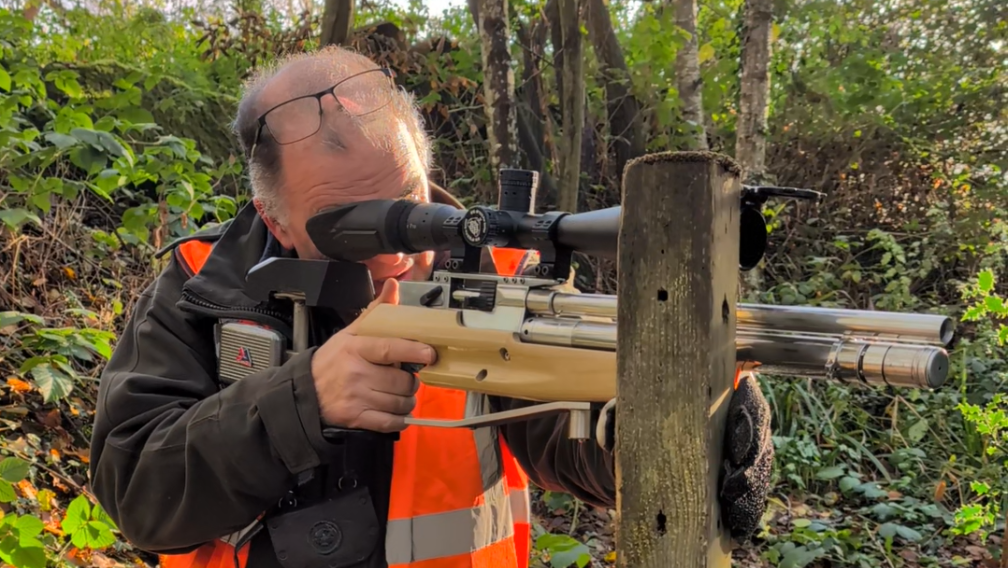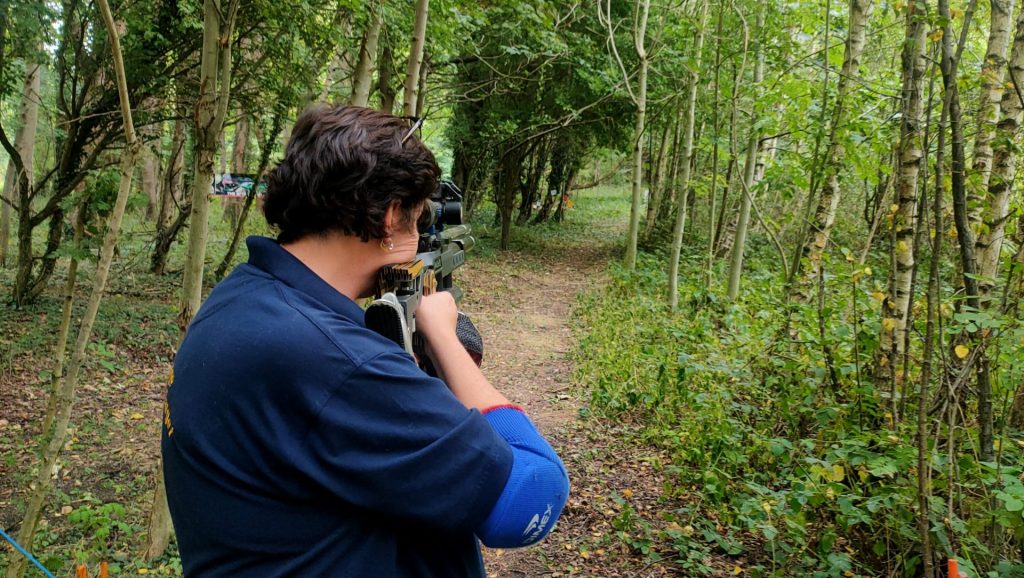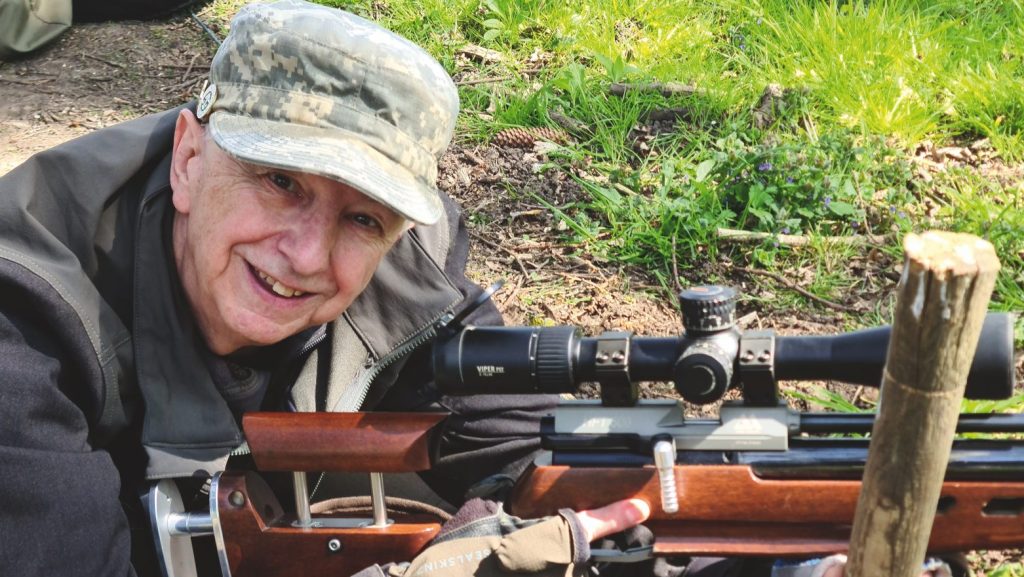Editor’s Test: EBA Agincourt PCP
Dave Barham reveals a brand-new rifle package from Edgar Brothers Arms, which costs less than £500.

When I first saw the EBA Agincourt rifle at the British Shooting Show, I was very impressed and couldn’t wait to get my hands on one. Here’s how this new rifle has performed over the past month of testing.
Lovely Stock
The first thing you notice when you open the supplied hard carry case is the beautiful piece of wood that forms the stock of the Agincourt. I tend to refer to these sorts of wooden stocks as ‘raw wood’ because they look and feel like they’ve just come out of the mill, with just a little light sanding. This finish gives the wood some texture; it’s not rough, but it’s also not silky smooth.
I love stocks like this because it leaves it up to the owner to decide whether they want to keep the ‘raw’ look and feel, or if they prefer to apply numerous coats of oil or wax to achieve a fine polish. The choice is yours.
The stock features ample laser-cut chequering on the pistol grip and fore end, providing essential grip, and the cheek riser is ambidextrous. The trigger guard is quite large and is actually carved out of the solid stock, which I really like.
Additionally, there are sling studs fitted at the fore end and on the butt of the stock, just in front of the ventilated rubber butt pad. A removable 3-inch Picatinny rail is fitted up front, allowing you to attach the supplied ‘Grip-pod’ bipod, which is a nice touch for the package price. Lastly, a laser-etched Edgar Brothers logo on the base of the pistol grip adds a touch of class.
Shrouded Barrel
The 530mm-long barrel is fully shrouded, and there is a 1/2 inch UNF thread hidden underneath the removable end cap. I tested this rifle both without a silencer and with one attached; the silencer definitely made a big difference, cutting down the noise considerably.
Moving on to the smooth sidelever action, it is much smoother than I anticipated. There’s a long 40mm drop-down handle that makes pulling the lever back just past the 90-degree position to cock the rifle a doddle. The lever is spring-assisted, making it easy to start the pull. Once cocked, gently sliding the lever forward sends the pellet probe through the magazine and loads your pellet – it’s all very slick and not clunky at all.
A manual safety lever is situated immediately behind the cocking lever and directly above the trigger guard. This operates with a push forward for ‘Safe’ and a pull back for ‘Fire’. It’s very positive and quite light to operate.
On top of the action, there is a split Picatinny rail where you can use two-piece mounts to attach your chosen scope.
Great Trigger
Now, let me tell you about the trigger. It’s a two-stage adjustable model, with the added bonus of being able to adjust the blade height and angle via a tiny screw that holds the blade to the post. Straight out of the box, I found the first stage pull to be extremely short, leading to a very solid stop, making it easy to predict the second-stage break. There’s absolutely no creep at all, and after just a few minutes of use, I really got to know it. The blade is quite wide, measuring around 7.5mm across, and it is crescent-shaped. It feels great on the pad of your trigger finger, which fits nicely.
Decent Reservoir
Immediately below the barrel, there’s a 280cc air cylinder that can be filled to 200 bar. This gives approximately 140 shots in .177 and 160 shots in .22, or thereabouts. At the very end of the cylinder, you’ll find a branded fill gauge, which is color-coded and very easy to read. The fill port is hidden beneath a heavy-duty synthetic cap that simply rotates to allow access and then rotates back again to cover it, preventing any debris from getting in. This tried and tested system is very user-friendly.
Two Magazines
Speaking of ease of use, the magazines supplied with this rifle are simple to load. They’re the spring-loaded, clear cover type. Simply rotate the clear cover on top all the way anti-clockwise to tension the internal spring, flip it over, and drop a pellet in skirt-first to lock everything in place. Then, flip it back over and rotate the cover clockwise, dropping your pellets in head-first as you go.
The loaded magazine is inserted from the right-hand side, and there’s a molded groove and lip to ensure it slides in securely. A magnet also helps to secure the magazine in place once inserted. You get two magazines with the Agincourt, which hold 14 shots in .177 and 12 in .22. There’s also a bag of spares included, which contains a filling adapter, hex keys, O-rings, copper gaskets, and oil.
Performance
The Agincourt performed exactly as I expected on the range. The build quality is excellent, and it passed my all-important ‘rattle test’. If you pick this beauty up and give it a good shake, there isn’t a peep or the slightest hint of a rattle. It’s a very solid rifle.
At 30 meters, I was hitting fingernail groups with the .22 model sent to me for review. I really pushed my limits, moving further back in the range and consistently knocking over targets at 40 and then 45 meters. It’s slightly on the heavy side at just under 8.5 lbs unscoped, but you’re getting a lot of rifle here for less than £500. I’d have no problem taking this rifle out in the field in search of rabbits off a bipod or pigeons off sticks. It’s equally at home on the range as it is in the field. Hats off to Edgar Brothers for producing a traditionally styled PCP with a great price tag that does everything you could ever want.
Tech Specs
– Model: Agincourt
– Manufacturer: Edgar Brothers Arms
– Type: PCP, multi-shot rotary magazine
– Stock Material: Ambidextrous, wood
– Cocking: Sidelever
– Trigger: Two-stage, adjustable
– Safety: Manual
– Calibres: .177 and .22
– Overall Length: 1050mm (41.3in)
– Barrel Length: 530mm (20.9in)
– Weight: 3.84kg (8.5lbs) without scope
– Fill Pressure: 200 bar
– Cylinder Capacity: 280cc
– Magazine Capacity: 14 (.177), 12 (.22)
– Shots Per Fill: 140 (.177), 160 (.22)
– Energy of Test Rifle: Avg 11.3 ft.lbs. over 20 shots
– Variation (20 shots): 9fps
– Website: [www.edgarbrothers.com](http://www.edgarbrothers.com)
– Price: £499





